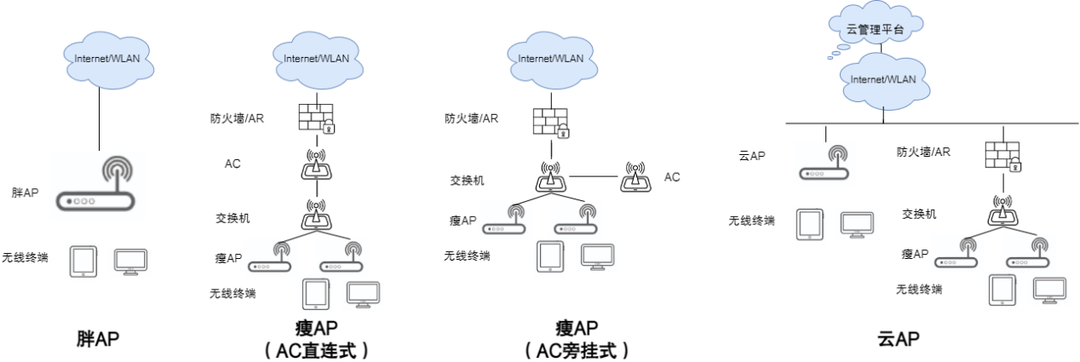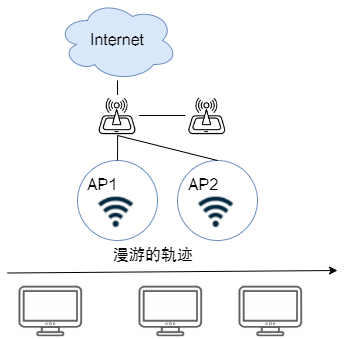Fat AP, thin AP or cloud AP?

Fat AP, thin AP or cloud AP?

Part 01
Introduction to AP
AP is a wireless access point (Wireless Access Point), which is used to transmit wireless signals, which is equivalent to a hub in a wired network and connects all wireless devices.
"Fat AP" generally refers to wireless routing, which is mostly used in homes and small networks. It has relatively complete functions, and one device can realize access, authentication, routing, VPN, and address translation. Used in small supermarkets and restaurants.
"Thin AP" generally refers to a wireless gateway or a bridge, and is mostly used in a demanding environment. It cannot be configured by itself, and needs to be configured through the wireless controller WLAN AC (Access Controller). It is suitable for large-scale wireless deployment, and is generally applicable to schools, large offices, hotels, and guesthouses.
"Cloud AP" needs to be used in conjunction with the cloud platform. It can support both small and medium-sized simple networks and large-scale complex networks. It is a network cloud-based management method that is gradually emerging. At the same time, due to the openness of the cloud platform, it can provide a wealth of industry applications, and is gradually favored by enterprises from all walks of life.

Figure 1 Wireless networking mode
Part 02
AP function
In addition to the wireless access function, "fat AP" generally supports security functions such as DHCP server, DNS, VPN access, and firewall. "Fat AP" usually comes with a simple management system, which can work independently and realize functions such as dialing and routing.
"Thin AP" removes functions such as routing, DNS, and DHCP server on the basis of "fat AP", and only retains the function of wireless access. It needs to cooperate with a wireless controller (WLAN AC) to form a complete network system, and cannot work independently.
So does it mean that "fat AP" has more functions, and "fat AP" is better than "thin AP"? The answer is the opposite.
The "thin AP" networking solution has the following advantages:
1. Network scale and application scenarios
"Fat AP" is generally used in small wireless network construction and can work independently without the cooperation of AC. It is generally applied to scenes that only need a small amount to fully cover, such as large bays.
"Thin AP" is generally used in the construction of medium and large wireless networks. A certain number of APs and AC products are used to build a larger wireless network coverage. The usage scenarios are generally villas, shopping malls, supermarkets, scenic spots, hotels, restaurants and entertainment, and corporate offices. Wait.
2. Wireless Roaming
"Fat AP" networking cannot implement wireless roaming. When the user walks from the coverage area of one "fat AP" to the coverage area of another "fat AP", he will reconnect to a "fat AP" with a strong signal to re-authenticate and obtain an IP address again, resulting in network disconnection.
Due to the management of WLAN AC and cloud platform, "thin AP" and "cloud AP" networking can realize fast roaming, automatic signal switching, no need to re-authenticate, no need to re-obtain IP address, and the network is always connected online. At the same time, users can be automatically assigned to other APs with lighter loads according to the load balancing algorithm, which improves the Wi-Fi performance of the entire network and ensures the Wi-Fi experience of each access terminal.

Figure 2 Wireless Roaming
"Cloud AP" has functions similar to "fat AP" and supports functions such as routing and DHCP server, so it can be applied to small-scale networking in homes or SOHO environments; and because it cooperates with the control function of the cloud platform, it is also suitable for communication with switches, AR and A large-scale network composed of firewalls; and the openness of the cloud platform further enriches the overall network performance of the "cloud AP" network.
Part 03
AP configuration management and maintenance
"Fat APs" cannot be managed in a centralized manner and need to be configured individually. The management and maintenance work is very cumbersome.
"Thin AP" can use WLAN AC for centralized management without separate configuration. The high-end wireless controller (WLAN AC) can manage hundreds of APs, and the configuration can be distributed centrally at one time. However, for ultra-large-scale networking of multiple WLAN ACs, it is necessary to log in to the ACs corresponding to the APs one by one for configuration, and the workload of O&M and management will double as the number of WLAN ACs increases.
"Cloud AP" can perform remote cloud network planning, cloud configuration, cloud inspection, and cloud operation and maintenance on the cloud platform, and perform centralized management and operation of the entire life cycle for large-scale AP networks at multiple sites. For example, if the "cloud AP" pre-configuration is completed on the cloud management platform, the network deployment construction site only needs to power on the AP and connect the network port to realize plug-and-play, and the pre-configuration on the "cloud platform" will be automatically delivered to the On the device, the network deployment time is greatly shortened. The cloud platform can comprehensively and intuitively monitor site status, device status, and terminal connection status, and efficiently manage network and business operations.